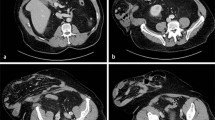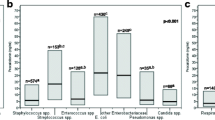Abstract
Purpose
Secondary peritonitis remains challenging to manage and some recent evidence suggests that on-demand relaparotomy is more appropriate than planned relaparotomy. This study was designed to validate the predictive power of postoperative procalcitonin (PCT) changes in relation to elimination of the septic abdominal focus.
Methods
In this prospective trial, postoperative PCT serum levels were monitored in 234 surgical patients with secondary peritonitis. The PCT ratio on postoperative days (PODs) 1 and 2 (focus index; FI) was calculated and correlated with the success of the operation.
Results
A cutoff value of 1.1 was calculated for the FI. Values below 1.1 indicated insufficient elimination of the focus and values above 1.1 correlated with effective treatment. The optimal time for first PCT sampling was found to be 12–24 h after the index operation. After the respective data cleanup, successful elimination of the intraabdominal focus could be confirmed, with a sensitivity of 93 % and a specificity of 71 %.
Conclusions
The FI is a single parameter-based reliable predictor of successful surgical eradication and strengthens the on-demand relaparotomy concept as the method of choice to treat secondary peritonitis.





Similar content being viewed by others
References
Nathens AB, Rotstein OD. Therapeutic options in peritonitis. Surg Clin North Am. 1994;74(3):677–92.
van Ruler O, Mahler CW, Boer KR, Reuland EA, Gooszen HG, Opmeer BC, et al. Comparison of on-demand vs planned relaparotomy strategy in patients with severe peritonitis: a randomized trial. JAMA J Am Med Assoc. 2007;298(8):865–72.
Lamme B, Boermeester MA, Belt EJ, van Till JW, Gouma DJ, Obertop H. Mortality and morbidity of planned relaparotomy versus relaparotomy on demand for secondary peritonitis. Br J Surg. 2004;91(8):1046–54.
Opmeer BC, Boer KR, van Ruler O, Reitsma JB, Gooszen HG, de Graaf PW, et al. Costs of relaparotomy on-demand versus planned relaparotomy in patients with severe peritonitis: an economic evaluation within a randomized controlled trial. Crit Care. 2010;14(3):R97.
Bohnen J, Boulanger M, Meakins JL, McLean AP. Prognosis in generalized peritonitis. Relation to cause and risk factors. Arch Surg. 1983;118(3):285–90.
Evans HL, Raymond DP, Pelletier SJ, Crabtree TD, Pruett TL, Sawyer RG. Diagnosis of intra-abdominal infection in the critically ill patient. Curr Opin Crit Care. 2001;7(2):117–21.
Fujita F, Torashima Y, Kuroki T, Eguchi S. The risk factors and predictive factors for anastomotic leakage after resection for colorectal cancer: reappraisal of the literature. Surg Today. 2014;44(9):1595–602.
Bosscha K, van Vroonhoven TJ, van der Werken C. Surgical management of severe secondary peritonitis. Br J Surg. 1999;86(11):1371–7.
Farthmann EH, Schoffel U. Principles and limitations of operative management of intraabdominal infections. World J Surg. 1990;14(2):210–7.
Kobayashi M, Mohri Y, Ohi M, Inoue Y, Araki T, Okita Y, et al. Risk factors for anastomotic leakage and favorable antimicrobial treatment as empirical therapy for intra-abdominal infection in patients undergoing colorectal surgery. Surg Today. 2014;44(3):487–93.
Novotny AR, Emmanuel K, Hueser N, Knebel C, Kriner M, Ulm K, et al. Procalcitonin ratio indicates successful surgical treatment of abdominal sepsis. Surgery. 2009;145(1):20–6.
van Ruler O, Lamme B, Gouma DJ, Reitsma JB, Boermeester MA. Variables associated with positive findings at relaparotomy in patients with secondary peritonitis. Crit Care Med. 2007;35(2):468–76.
Nakamura A, Wada H, Ikejiri M, Hatada T, Sakurai H, Matsushima Y, et al. Efficacy of procalcitonin in the early diagnosis of bacterial infections in a critical care unit. Shock. 2009;31(6):586–91.
Brunkhorst FM, Wegscheider K, Forycki ZF, Brunkhorst R. Procalcitonin for early diagnosis and differentiation of SIRS, sepsis, severe sepsis, and septic shock. Intensive Care Med. 2000;26(Suppl 2):S148–52.
Luzzani A, Polati E, Dorizzi R, Rungatscher A, Pavan R, Merlini A. Comparison of procalcitonin and C-reactive protein as markers of sepsis. Crit Care Med. 2003;31(6):1737–41.
Tschaikowsky K, Hedwig-Geissing M, Braun GG, Radespiel-Troeger M. Predictive value of procalcitonin, interleukin-6, and C-reactive protein for survival in postoperative patients with severe sepsis. J Crit Care. 2011;26(1):54–64.
Reith HB, Mittelkotter U, Wagner R, Thiede A. Procalcitonin (PCT) in patients with abdominal sepsis. Intensive Care Med. 2000;26(Suppl 2):S165–9.
Iapichino G, Marzorati S, Umbrello M, Baccalini R, Barassi A, Cainarca M, et al. Daily monitoring of biomarkers of sepsis in complicated long-term ICU-patients: can it support treatment decisions? Minerva Anestesiol. 2010;76(10):814–23.
Assicot M, Gendrel D, Carsin H, Raymond J, Guilbaud J, Bohuon C. High serum procalcitonin concentrations in patients with sepsis and infection. Lancet. 1993;341(8844):515–8.
Linscheid P, Seboek D, Schaer DJ, Zulewski H, Keller U, Muller B. Expression and secretion of procalcitonin and calcitonin gene-related peptide by adherent monocytes and by macrophage-activated adipocytes. Crit Care Med. 2004;32(8):1715–21.
Russwurm S, Stonans I, Stonane E, Wiederhold M, Luber A, Zipfel PF, et al. Procalcitonin and CGRP-1 mrna expression in various human tissues. Shock. 2001;16(2):109–12.
Meisner M, Muller V, Khakpour Z, Toegel E, Redl H. Induction of procalcitonin and proinflammatory cytokines in an anhepatic baboon endotoxin shock model. Shock. 2003;19(2):187–90.
Dahaba AA, Metzler H. Procalcitonin’s role in the sepsis cascade. Is procalcitonin a sepsis marker or mediator? Min Anestesiol. 2009;75(7–8):447–52.
Dandona P, Nix D, Wilson MF, Aljada A, Love J, Assicot M, et al. Procalcitonin increase after endotoxin injection in normal subjects. J Clin Endocrinol Metab. 1994;79(6):1605–8.
Meisner M, Schmidt J, Huttner H, Tschaikowsky K. The natural elimination rate of procalcitonin in patients with normal and impaired renal function. Intensive Care Med. 2000;26(Suppl 2):S212–6.
Karlsson S, Heikkinen M, Pettila V, Alila S, Vaisanen S, Pulkki K, et al. Predictive value of procalcitonin decrease in patients with severe sepsis: a prospective observational study. Crit Care. 2010;14(6):R205.
Reinhart K, Meisner M. Biomarkers in the critically ill patient: procalcitonin. Crit Care Clin. 2011;27(2):253–63.
Charles PE, Ladoire S, Aho S, Quenot JP, Doise JM, Prin S, et al. Serum procalcitonin elevation in critically ill patients at the onset of bacteremia caused by either Gram negative or Gram positive bacteria. BMC Infect Dis. 2008;8:38.
Charles PE, Tinel C, Barbar S, Aho S, Prin S, Doise JM, et al. Procalcitonin kinetics within the first days of sepsis: relationship with the appropriateness of antibiotic therapy and the outcome. Crit Care. 2009;13(2):R38.
Georgopoulou AP, Savva A, Giamarellos-Bourboulis EJ, Georgitsi M, Raftogiannis M, Antonakos N, et al. Early changes of procalcitonin may advise about prognosis and appropriateness of antimicrobial therapy in sepsis. J Critical Care. 2011;26(3):331e1–7.
Hochreiter M, Kohler T, Schweiger AM, Keck FS, Bein B, von Spiegel T, et al. Procalcitonin to guide duration of antibiotic therapy in intensive care patients: a randomized prospective controlled trial. Crit Care. 2009;13(3):R83.
Charles PE, Ladoire S, Snauwaert A, Prin S, Aho S, Pechinot A, et al. Impact of previous sepsis on the accuracy of procalcitonin for the early diagnosis of blood stream infection in critically ill patients. BMC Infect Dis. 2008;8:163.
Novotny A, Emmanuel K, Matevossian E, Kriner M, Ulm K, Bartels H, et al. Use of procalcitonin for early prediction of lethal outcome of postoperative sepsis. Am J Surg. 2007;194(1):35–9.
Friederichs J, Hutter M, Hierholzer C, Novotny A, Friess H, Buhren V, et al. Procalcitonin ratio as a predictor of successful surgical treatment of severe necrotizing soft tissue infections. Am J Surg. 2013;206(3):368–73.
Koperna T, Schulz F. Relaparotomy in peritonitis: prognosis and treatment of patients with persisting intraabdominal infection. World J Surg. 2000;24(1):32–7.
Bone RC. Let’s agree on terminology: definitions of sepsis. Crit Care Med. 1991;19(7):973–6.
Bone RC, Balk RA, Cerra FB, Dellinger RP, Fein AM, Knaus WA, et al. Definitions for sepsis and organ failure and guidelines for the use of innovative therapies in sepsis. The ACCP/SCCM Consensus Conference Committee. American College of Chest Physicians/Society of Critical Care Medicine. Chest. 1992;101(6):1644–55.
Chang RW, Jacobs S, Lee B. Predicting outcome among intensive care unit patients using computerised trend analysis of daily Apache II scores corrected for organ system failure. Intensive Care Med. 1988;14(5):558–66.
Meisner M, Tschaikowsky K, Hutzler A, Schick C, Schuttler J. Postoperative plasma concentrations of procalcitonin after different types of surgery. Intensive Care Med. 1998;24(7):680–4.
Lamme B, Mahler CW, van Ruler O, Gouma DJ, Reitsma JB, Boermeester MA. Clinical predictors of ongoing infection in secondary peritonitis: systematic review. World J Surg. 2006;30(12):2170–81.
Pierrakos C, Vincent JL. Sepsis biomarkers: a review. Crit Care. 2010;14(1):R15.
Castelli GP, Pognani C, Cita M, Paladini R. Procalcitonin as a prognostic and diagnostic tool for septic complications after major trauma. Crit Care Med. 2009;37(6):1845–9.
Meng FS, Su L, Tang YQ, Wen Q, Liu YS, Liu ZF. Serum procalcitonin at the time of admission to the ICU as a predictor of short-term mortality. Clin Biochem. 2009;42(10–11):1025–31.
Patil VK, Morjaria JB, De Villers F, Babu SK. Associations between procalcitonin and markers of bacterial sepsis. Medicina. 2012;48(8):383–7.
Ravishankaran P, Shah AM, Bhat R. Correlation of interleukin-6, serum lactate, and C-reactive protein to inflammation, complication, and outcome during the surgical course of patients with acute abdomen. J Interferon Cytokine Res. 2011;31(9):685–90.
Author information
Authors and Affiliations
Corresponding author
Ethics declarations
Conflict of interest
There are no conflicts of interest and no funding.
Rights and permissions
About this article
Cite this article
Assfalg, V., Wolf, P., Reim, D. et al. Procalcitonin ratio and on-demand relaparotomy for septic peritonitis: validation of the focus index (FI). Surg Today 46, 603–612 (2016). https://doi.org/10.1007/s00595-015-1226-z
Received:
Accepted:
Published:
Issue Date:
DOI: https://doi.org/10.1007/s00595-015-1226-z




